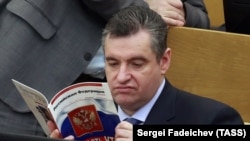On Wednesday, September 5, British police revealed the names and published the photos of two Russian men they say flew to Britain over a weekend in March to poison former Russian spy Sergei Skripal and his daughter Yulia in the city of Salisbury. Authorities say the two suspects used Novichok, the Russian-made military grade nerve agent, to poison Skripal and daughter, both of whom survived.
Neil Basu, the head of Brtain’s counter-terrorism police, said the attack was a “remarkably sophisticated” assassination attempt. Prime Minister Theresa May told Parliament the government had concluded the two suspects were officers in Russia’s military intelligence service, the GRU.
“The GRU is a highly disciplined organization with a well-established chain of command, so this was not a rogue operation,” May said. “It was almost certainly also approved outside the GRU at a senior level of the Russian state.”
The Russian authorities, including the Foreign Ministry, top lawmakers and the state-controlled media, responded to the British announcement using the classic Soviet military strategy of maskirovka, a doctrine of deception that includes such measures as concealment, imitation using decoys and dummies, maneuvers of deception, denial, and disinformation.
Leonid Slutsky, chairman of the Foreign Affairs Committee of the State Duma, the lower chamber of Russia’s parliament, dismissed the British investigation as an “anti-Russian provocation.”
”Britain is continuing its massive anti-Russian provocation. In the Skripals’ case, people have been officially indicted whose names do not tell [us] anything yet. It is announced that they are officers of the GRU. That is an absolute drivel,” Slutsky said.
The Life.ru website, known for its ties Russia’s FSB intelligence service, mocked the investigation, the British people and their prime minister with a piece headlined “Are you crazy, May?”
However, it was Russian Foreign Ministry’s spokesperson Maria Zakharova who used the art of maskirovka with greatest mastery.
Zakharova expressed outrage over the British refusal to release information critical for the investigation. That is, in fact, the opposite of what the British authorities did: they have released all the information Moscow would need to identify the two suspects.
The Russian authorities could run the photos of the two suspects through their massive facial recognition database, or check the data base of Zakharova’s Foreign Ministry for travel passports that have been issue. There are other details that provide Russia with information to identify the two men.
The British police report includes data on the date, time and point of the two suspects’ exit from Russia. It also reveals the number of the commercial flight they took to Britain.
“At 3 pm on Friday, 2 March, the suspects arrived at Gatwick airport, having flown from Moscow on Aeroflot flight SU2588,” the British counterterrorism police report states.
Aeroflot flight SU2588 is a regular daily direct flight from Moscow’s Sheremetyevo airport to Gatwick, London.
Sheremetyevo International Airport in Moscow, Russia’s largest airport, is, according to its official Web page, “equipped with the latest security systems: entrances and checkpoints have metal detectors and X-rays, microwave scanners, and advanced gas sensors. We have introduced a multi-level system for automatic 100% baggage inspection and analytical video surveillance that can detect potentially hazardous objects according to set parameters.”.
Besides an airport security check, every passenger traveling abroad must pass through customs control, which includes checking passengers’ travel documents, interviewing them and searching both their belongings and person. Passengers must first pass through flight registration before going through customs control.
Thus, to obtain the information Zakharova says the British authorities are refusing to share, all Russian authorities need to do is check the passenger manifest for Aeroflot flight SU2588 on March 2, 2018.
In the months after the poisoning of Skripal and his daughter Yulia, Polygraph.info debunked more than 40 different claims made by Moscow, all questioning whether the crime actually took place designed to cause confusion about and foster distrust in the official agencies and the information they provide to the public. All of this followed the model of classic maskirovka











